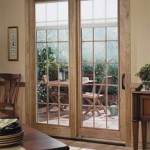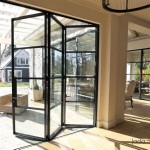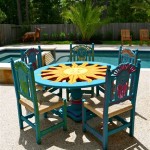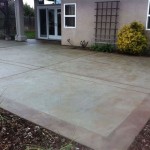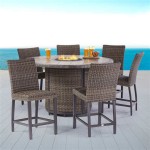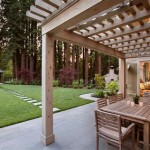How To Make A Small Paver Patio Look Bigger
Transforming a small paver patio into a space that feels larger and more inviting is achievable with careful planning and strategic design choices. Limited square footage does not have to equate to a cramped or unappealing outdoor living area. By employing visual tricks, optimizing layout, and selecting the right materials, a small patio can be made to feel significantly more expansive. The following article will detail several techniques to maximize the perceived size and enjoyment of a small paver patio.
Optimize Paver Size and Pattern
The size and pattern of the pavers themselves play a crucial role in determining the perceived dimensions of the patio. Larger pavers, generally, tend to create a sense of spaciousness compared to smaller, more intricate patterns. Using fewer, larger pavers visually reduces the number of lines and joints across the surface, minimizing visual clutter and creating a smoother, more expansive appearance. This streamlined aesthetic is particularly beneficial in compact spaces.
When considering paver patterns, avoid overly complex or busy arrangements. Simple, linear patterns, such as a running bond or a stack bond, are ideal for elongating the patio. The running bond, where pavers are offset by half their length in each row, creates a continuous visual line that draws the eye across the space. A stack bond, with pavers aligned directly on top of each other, offers a modern, clean aesthetic that minimizes distractions. Diagonal patterns can also be effective, as they visually expand the space by leading the eye towards the corners.
Contrastingly, smaller pavers and intricate patterns can make a small patio feel disjointed and even smaller. The numerous joints and visual complexity can overwhelm the space and make it appear cluttered. While intricate patterns can add visual interest, they are generally better suited for larger patios where their detail can be appreciated without sacrificing the sense of spaciousness.
The color of the pavers also impacts the perceived size of the patio. Lighter colors tend to reflect more light, making the area feel brighter and more open. Darker colors, while stylish, can absorb light and make the space feel smaller and more enclosed. Using lighter pavers, or a blend of light and neutral tones, can help to maximize the sense of openness on a small patio.
Beyond color, the texture of the pavers can contribute to the overall aesthetic. Smooth pavers create a more seamless surface, which can enhance the feeling of spaciousness. Highly textured pavers, while providing better traction, can add visual complexity and potentially make the patio feel smaller. Opting for pavers with a subtle texture allows for a balance between visual appeal and functionality.
Employ Vertical Elements and Strategic Landscaping
Expanding the perceived size of a small paver patio is not solely about the surface itself. Utilizing vertical elements and strategic landscaping can create the illusion of a larger space by drawing the eye upwards and outwards. This involves incorporating features that add height and depth to the patio design.
Vertical elements can include structures such as pergolas, arbors, or even tall planters. A pergola, for instance, provides a sense of enclosure without completely blocking the view, creating a defined space that feels separate from the surrounding area while still maintaining a connection to the landscape. The vertical lines of the pergola draw the eye upwards, making the patio feel taller and more spacious. Similarly, an arbor placed at the entrance to the patio can create a welcoming focal point and add visual interest.
Tall planters filled with lush greenery can also effectively create vertical interest. Choose tall, narrow planters to maximize the impact without taking up too much valuable floor space. The plants themselves should be selected carefully to complement the overall design. Consider using plants with varying heights, textures, and colors to create a visually appealing and dynamic landscape. Climbing plants, such as vines or clematis, can be trained to grow up trellises or pergolas, further enhancing the vertical dimension and adding a touch of nature to the patio.
When implementing landscaping around the patio, avoid creating a solid wall of shrubs or hedges that can visually enclose the space. Instead, opt for layered landscaping with plants of varying heights and textures. This creates a sense of depth and draws the eye outwards, making the patio feel larger. Use plants with lighter foliage colors in the background to create a sense of distance, and incorporate elements of surprise, such as hidden pathways or small water features, to encourage exploration and make the space feel more expansive.
Mirrors can also be used strategically to create the illusion of more space. Placing a mirror on a wall or fence can reflect the surrounding landscape, effectively doubling the perceived size of the patio. Choose a weatherproof mirror and position it carefully to avoid direct sunlight reflection, which can be distracting. A well-placed mirror can create a stunning visual effect and make a small patio feel significantly larger.
Select Furniture and Accessories Wisely
The choice of furniture and accessories is critical in maximizing the perceived space of a small paver patio. Overcrowding the patio with bulky furniture will only emphasize its limited size. Opting for smaller-scale, multi-functional pieces and carefully curated accessories can create a more open and inviting atmosphere.
Choose furniture that is proportionate to the size of the patio. Avoid large, oversized chairs or sofas that will take up too much space. Instead, consider smaller, more streamlined options such as bistro sets, folding chairs, or lightweight lounge chairs. Multi-functional furniture, such as benches with built-in storage or coffee tables that can be used as extra seating, can help to maximize space and provide practical solutions for storage.
When selecting furniture materials, consider lightweight options such as aluminum, wicker, or resin. These materials are not only durable and weather-resistant but also visually lighter than heavier materials like wrought iron or wood. Choosing furniture with open frames or thin legs can also help to create a more spacious feel by allowing more light to pass through the space.
Accessories should be chosen carefully to avoid cluttering the patio. Opt for a few well-chosen pieces that add visual interest without overwhelming the space. A colorful outdoor rug can define the seating area and add a touch of personality. Consider using neutral-colored rugs to create a more seamless look and avoid drawing attention to the limited size of the patio. Throw pillows and cushions can add comfort and style, but be sure to choose colors and patterns that complement the overall design and avoid overly busy or overwhelming patterns.
Lighting plays a crucial role in creating ambiance and making the patio feel larger, especially at night. String lights, lanterns, or strategically placed spotlights can illuminate the patio and highlight its features. Uplighting trees or shrubs around the patio can also create a sense of depth and draw the eye outwards. Avoid using harsh, overhead lighting, which can make the space feel smaller and less inviting. Instead, opt for soft, warm lighting that creates a cozy and relaxing atmosphere.
Maintaining a clutter-free patio is essential for maximizing its perceived size. Regularly declutter the space and remove any unnecessary items. Store cushions and other accessories when not in use, and keep the patio surface clean and free of debris. A well-maintained patio will always feel larger and more inviting than a cluttered one.
By carefully considering these factors – paver size and pattern, vertical elements and landscaping, and furniture and accessories – it is possible to transform a small paver patio into a visually appealing and functional outdoor space that feels significantly larger than its actual dimensions. Strategic design choices and attention to detail can make all the difference in creating a patio that is both beautiful and enjoyable.

9 Genius Tips To Make Your Small Garden Look Bigger
10 Small Paver Patio Ideas Aspire

9 Genius Tips To Make Your Small Garden Look Bigger

40 Paver Patio Ideas To Help You Design Your Outdoor Space

Take The Fun Outside With A Paver Patio Seattle Times

How To Build A Paver Patio Young House Love

5 Patio Paver Design Ideas For Your Backyard

Paver Patio Ideas Design Tips For Patios Unilock

How To Build A Patio In Weekend Fine Gardening

5 Ways To Make A Patio Have No Cuts
Related Posts

